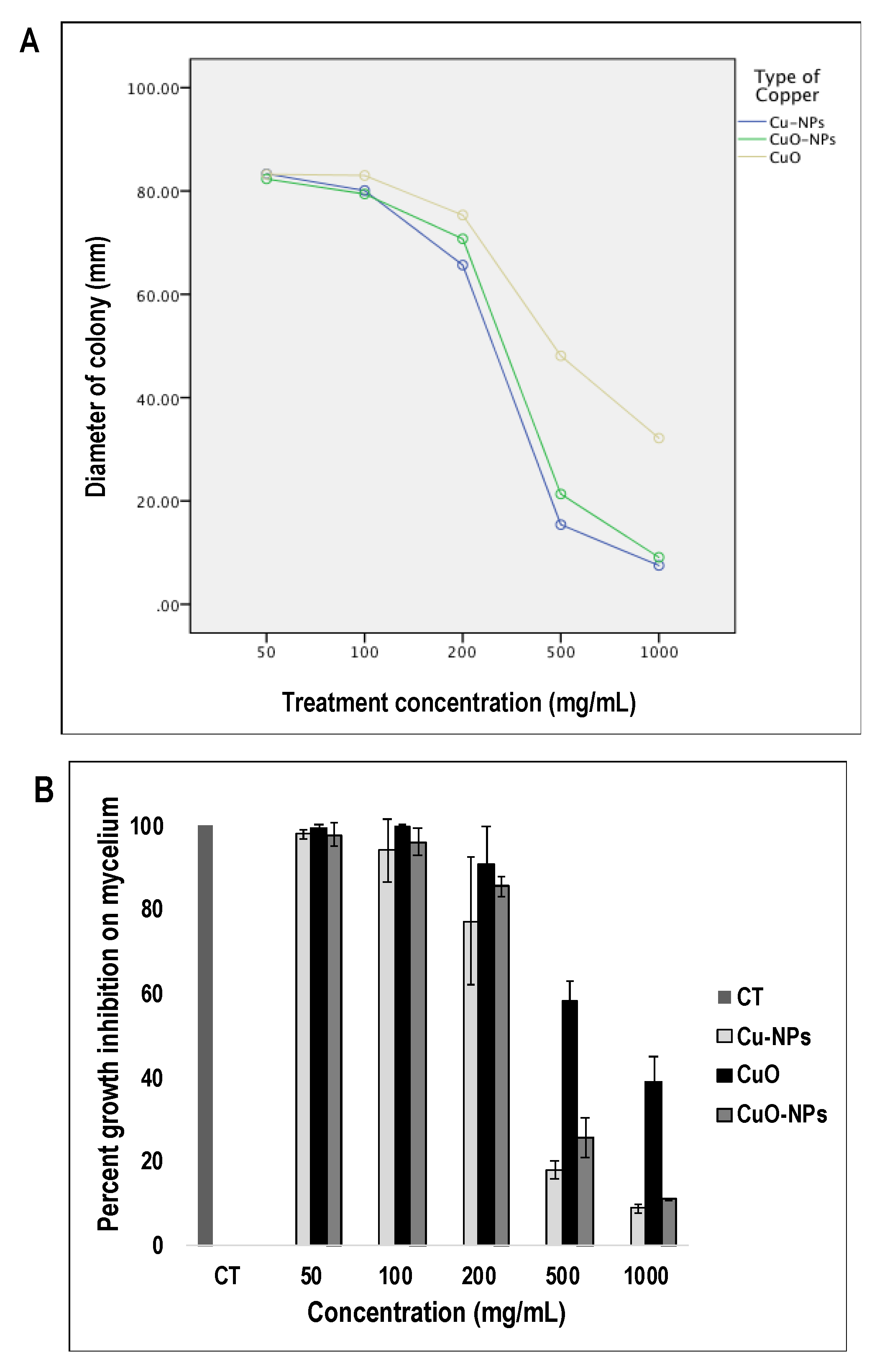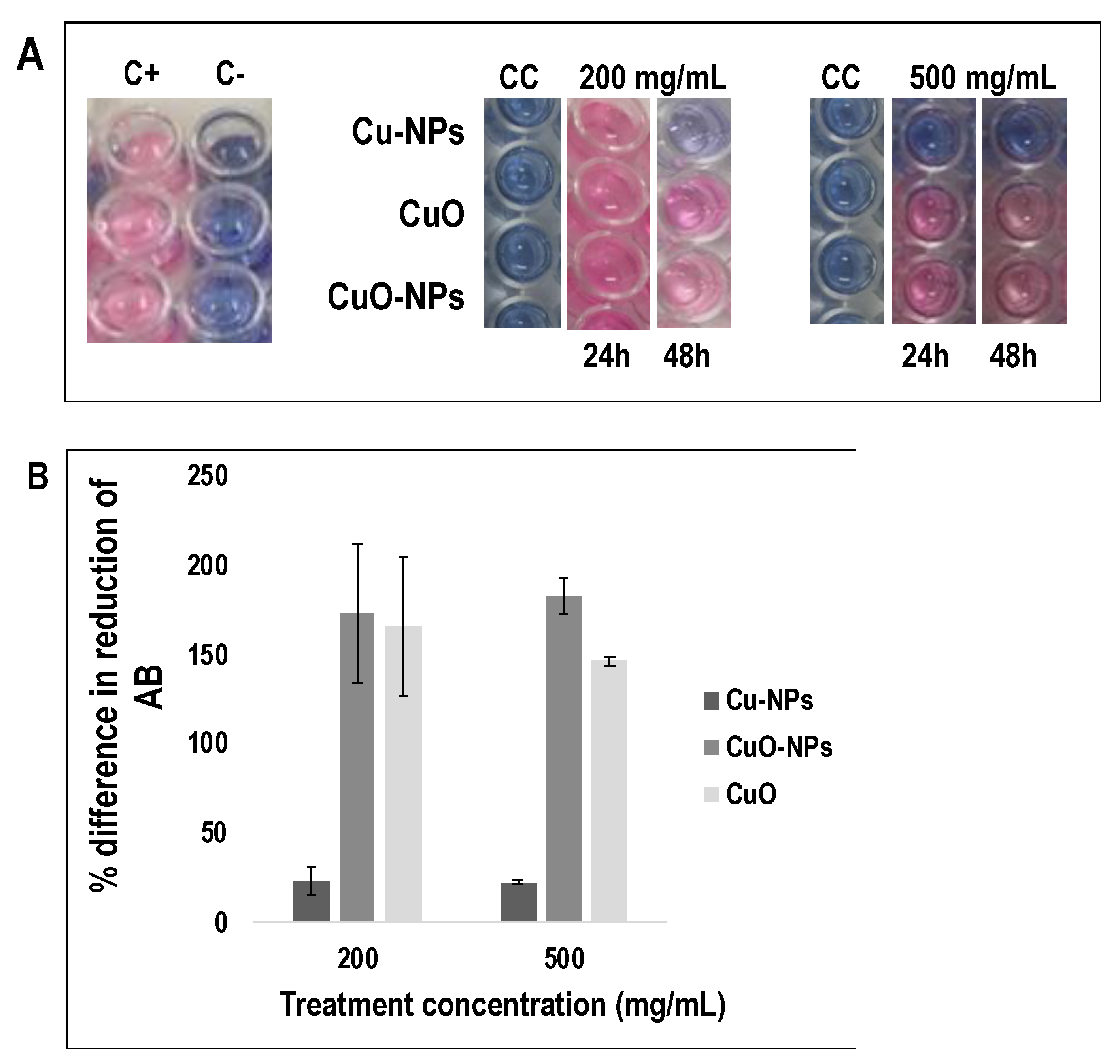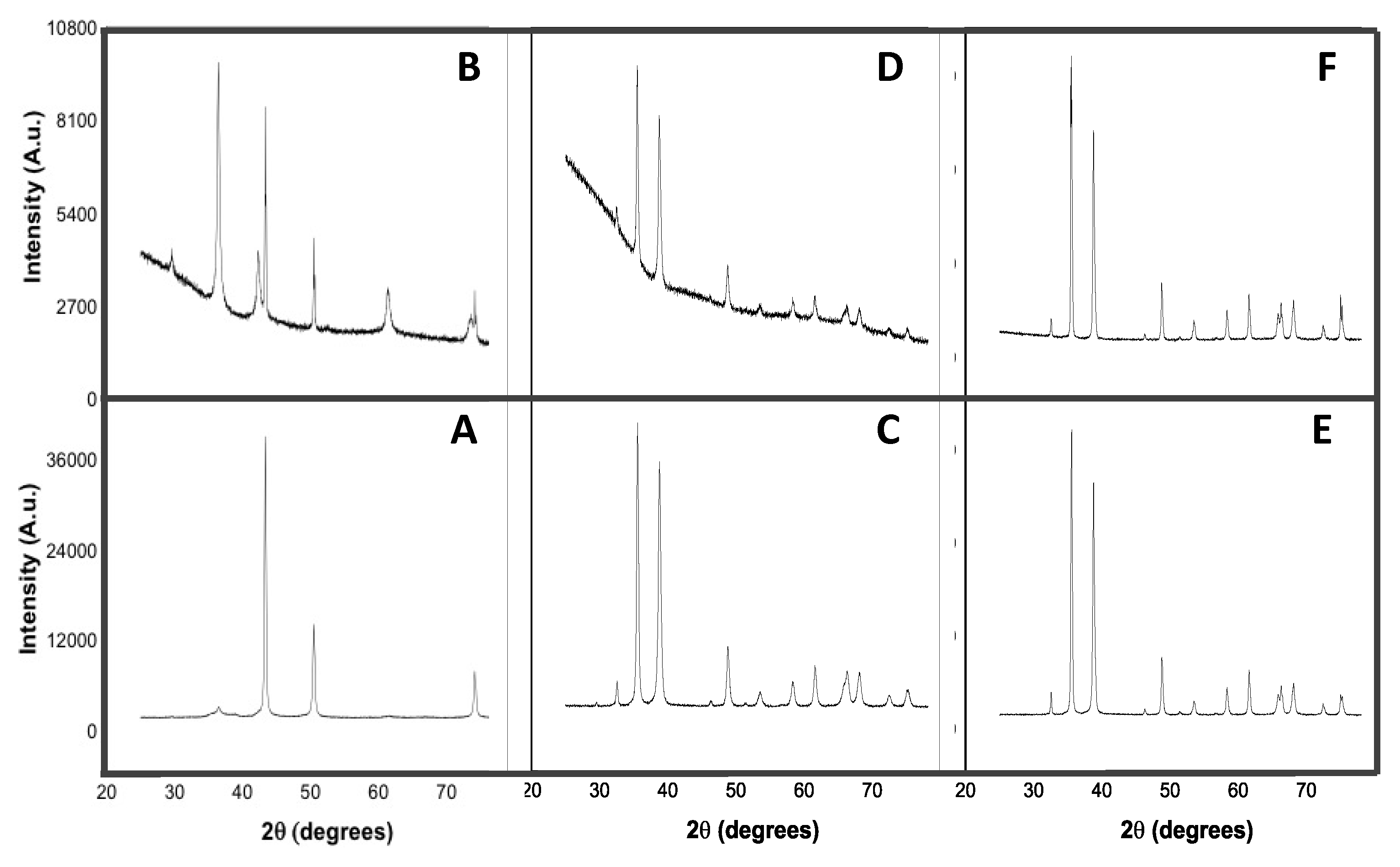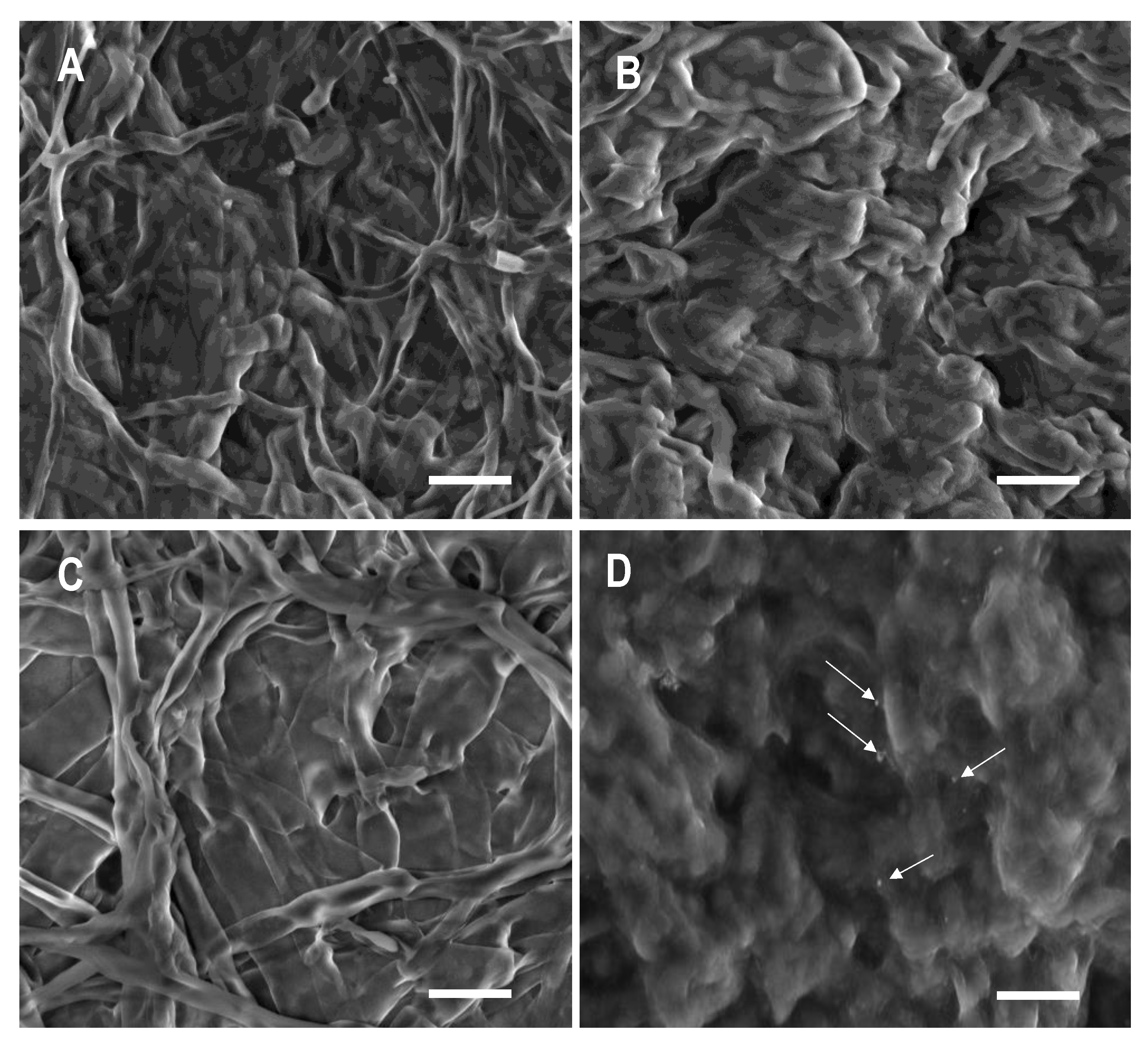Antifungal Potential of Nanostructured Crystalline Copper and Its Oxide Forms
Abstract
1. Introduction
2. Materials and Methods
2.1. Materials
2.2. Preparation of Copper and Copper Compounds
2.3. Hyphal Growth Measurement
2.4. Cell Viability Assays
2.4.1. Optimization of Culture Conditions
2.4.2. The Effect of Copper Nanoparticles and Oxide Forms on Cell Viability
2.5. X-ray Diffractogram (XRD) Characterization
2.6. Scanning Electron Microscopy (SEM)
2.7. Statistical Analyses
3. Results
3.1. Dose-Dependent Effects of Copper, and Its Oxidative Forms on Fungal Hyphal Growth
3.2. Effects of Copper NPs and Oxide Forms on Pathogen Cell Viability
3.3. X-ray Diffraction (XRD) Analysis of Copper forms
3.4. Effects of Copper Forms on the Ultrastructure of the Fungus
4. Discussion
Supplementary Materials
Author Contributions
Funding
Acknowledgments
Conflicts of Interest
References
- Kalinowska-Lis, U.; Felczak, A.; Chȩcińska, L.; Lisowska, K.; Ochocki, J. Synthesis, characterization and antimicrobial activity of silver(I) complexes of hydroxymethyl derivatives of pyridine and benzimidazole. J. Organomet. Chem. 2014, 749, 394–399. [Google Scholar] [CrossRef]
- Copper Facts: Antimicrobial Copper. Available online: Copper.org/education/c-facts/antimicrobial/print-category.html (accessed on 14 February 2020).
- Borkow, G.; Gabbay, J.; Zatcoff, R.C. Could chronic wounds not heal due to too low local copper levels? Med. Hypotheses 2008, 70, 610–613. [Google Scholar] [CrossRef] [PubMed]
- O’Gorman, J.; Humphreys, H. Application of copper to prevent and control infection. Where are we now? J. Hosp. Infect. 2012, 81, 217–223. [Google Scholar] [CrossRef] [PubMed]
- Walusinski, O. The Scientific Illusion of Victor Burq (1822-1884). Eur. Neurol. 2018, 79, 135–149. [Google Scholar] [CrossRef] [PubMed]
- Arendsen, L.P.; Thakar, R.; Sultan, A.H. The use of copper as an antimicrobial agent in health care, including obstetrics and gynecology. Clin. Microbiol. Rev. 2019, 32, e00125-18. [Google Scholar] [CrossRef]
- Salgado, C.D.; Sepkowitz, K.A.; John, J.F.; Cantey, J.R.; Attaway, H.H.; Freeman, K.D.; Sharpe, P.A.; Michels, H.T.; Schmidt, M.G. Copper Surfaces Reduce the Rate of Healthcare-Acquired Infections in the Intensive Care Unit. Infect. Control Hosp. Epidemiol. 2013, 34, 479–486. [Google Scholar] [CrossRef]
- Weaver, L.; Michels, H.T.; Keevil, C.W. Potential for preventing spread of fungi in air-conditioning systems constructed using copper instead of aluminium. Lett. Appl. Microbiol. 2010, 50, 18–23. [Google Scholar] [CrossRef]
- Noyce, J.O.; Michels, H.; Keevil, C.W. Potential use of copper surfaces to reduce survival of epidemic meticillin-resistant Staphylococcus aureus in the healthcare environment. J. Hosp. Infect. 2006, 63, 289–297. [Google Scholar] [CrossRef]
- Omae, I. General aspects of tin-free antifouling paints. Chem. Rev. 2003, 103, 3431–3448. [Google Scholar] [CrossRef]
- Borkow, G.; Gabbay, J. Putting copper into action: Copper-impregnated products with potent biocidal activities. FASEB J. 2004. [Google Scholar] [CrossRef]
- Delgado, K.; Quijada, R.; Palma, R.; Palza, H. Polypropylene with embedded copper metal or copper oxide nanoparticles as a novel plastic antimicrobial agent. Lett. Appl. Microbiol. 2011, 53, 50–54. [Google Scholar] [CrossRef] [PubMed]
- Theivasanthi, T.; Alagar, M. X-ray Diffraction Studies of Copper Nanopowder. Arch. Phys. Res. 2010, 1, 112–117. [Google Scholar]
- Morones, J.R.; Elechiguerra, J.L.; Camacho, A.; Holt, K.; Kouri, J.B.; Ramírez, J.T.; Yacaman, M.J. The bactericidal effect of silver nanoparticles. Nanotechnology 2005, 16, 2346–2353. [Google Scholar] [CrossRef] [PubMed]
- De, M.; Ghosh, P.S.; Rotello, V.M. Applications of nanoparticles in biology. Adv. Mater. 2008, 20, 4225–4241. [Google Scholar] [CrossRef]
- Biener, J.; Wittstock, A.; Baumann, T.F.; Weissmüller, J.; Bäumer, M.; Hamza, A.V. Surface chemistry in nanoscale materials. Materials 2009, 2, 2404–2428. [Google Scholar] [CrossRef]
- Yadollahi, R.; Vasilev, K.; Simovic, S. Nanosuspension technologies for delivery of poorly soluble drugs. J. Nanomater. 2015. [Google Scholar] [CrossRef]
- Kim, J.S.; Kuk, E.; Yu, K.N.; Kim, J.H.; Park, S.J.; Lee, H.J.; Kim, S.H.; Park, Y.K.; Park, Y.H.; Hwang, C.Y.; et al. Antimicrobial effects of silver nanoparticles. Nanomedicine Nanotechnol. Biol. Med. 2007, 3, 95–101. [Google Scholar] [CrossRef]
- Min, J.S.; Kim, K.S.; Kim, S.W.; Jung, J.H.; Lamsal, K.; Kim, S.B.; Jung, M.Y.; Lee, Y.S. Effects of colloidal silver nanoparticles on sclerotium-forming phytopathogenic fungi. Plant Pathol. J. 2009, 25, 376–380. [Google Scholar] [CrossRef]
- AshaRani, P.V.; Hande, M.P.; Valiyaveettil, S. Anti-proliferative activity of silver nanoparticles. BMC Cell Biol. 2009, 10, 65. [Google Scholar] [CrossRef]
- Mahmoudi, M.; Serpooshan, V. Silver-coated engineered magnetic nanoparticles are promising for the success in the fight against antibacterial resistance threat. ACS Nano 2012, 6, 2656–2664. [Google Scholar] [CrossRef]
- Hajji, S.; Younes, I.; Rinaudo, M.; Jellouli, K.; Nasri, M. Characterization and In Vitro Evaluation of Cytotoxicity, Antimicrobial and Antioxidant Activities of Chitosans Extracted from Three Different Marine Sources. Appl. Biochem. Biotechnol. 2015, 127, 18–35. [Google Scholar] [CrossRef] [PubMed]
- Dananjaya, S.H.S.; Godahewa, G.I.; Jayasooriya, R.G.P.T.; Lee, J.; De Zoysa, M. Antimicrobial effects of chitosan silver nano composites (CAgNCs) on fish pathogenic Aliivibrio (Vibrio) salmonicida. Aquaculture 2016, 450, 422–430. [Google Scholar] [CrossRef]
- Al-Johani, B.; Khan, A.N.; Alamshany, Z.M.; Gull, M.; Azam, E.S.; Kosa, S.A. Synthesis, Electrochemical and Antimicrobial Activity of Colloidal Copper Nanoparticles. Biosci. Biotechnol. Res. Asia 2017, 14, 1259–1268. [Google Scholar] [CrossRef]
- Ren, G.; Hu, D.; Cheng, E.W.C.; Vargas-Reus, M.A.; Reip, P.; Allaker, R.P. Characterisation of copper oxide nanoparticles for antimicrobial applications. Int. J. Antimicrob. Agents 2009, 33, 587–590. [Google Scholar] [CrossRef] [PubMed]
- Hajipour, M.J.; Fromm, K.M.; Ashkarran, A.A.; de Aberasturi, D.J.; de Larramendi, I.R.; Rojo, T.; Serpooshan, V.; Parak, W.J.; Mahmoudi, M. Antibacterial properties of nanoparticles. Trends Biotechnol. 2012, 30, 499–511. [Google Scholar] [CrossRef] [PubMed]
- Giljohann, D.A.; Seferos, D.S.; Daniel, W.L.; Massich, M.D.; Patel, P.C.; Mirkin, C.A. Gold Nanoparticles for Biology and Medicine. Angew. Chem. Int. Ed. 2010, 49, 3280–3294. [Google Scholar] [CrossRef] [PubMed]
- Utreja, P.; Verma, S.; Rahman, M.; Kumar, L. Use of Nanoparticles in Medicine. Curr. Biochem. Eng. 2020, 6, 7–24. [Google Scholar] [CrossRef]
- Chung, W.H.; Ishii, H.; Nishimura, K.; Fukaya, M.; Yano, K.; Kajitani, Y. Fungicide sensitivity and phylogenetic relationship of anthracnose fungi isolated from various fruit crops in Japan. Plant Dis. 2006, 90, 506–512. [Google Scholar] [CrossRef]
- De Lima Castro, S.A.; Gonçalves-Vidigal, M.C.; Gilio, T.A.S.; Lacanallo, G.F.; Valentini, G.; da Silva Ramos Martins, V.; Song, Q.; Galván, M.Z.; Hurtado-Gonzales, O.P.; Pastor-Corrales, M.A. Genetics and mapping of a new anthracnose resistance locus in Andean common bean Paloma. BMC Genomics 2017, 18, 306. [Google Scholar] [CrossRef]
- Uaciquete, A.; Korsten, L.; Van der Waals, J.E. Epidemiology of cashew anthracnose (Colletotrichum gloeosporioides Penz.) in Mozambique. Crop. Prot. 2013, 49, 66–72. [Google Scholar] [CrossRef][Green Version]
- Pingchai, P.; Cheewangkoon, R.; To-Anun, C. Controlling anthracnose of Passion fruit by antagonistic yeast. Int. J. Agric. Technol. 2017, 13, 205–212. [Google Scholar]
- Martinez-Culebras, P.V.; Querol, A.; Suarez-Fernandez, M.B.; Garcia-Lopez, M.D.; Barrio, E. Phylogenetic relationships among Colletotrichum pathogens of strawberry and design of PCR primers for their identification. J. Phytopathol. 2003, 151, 135–143. [Google Scholar] [CrossRef]
- Gupta, V.K.; Pandey, A.; Kumar, P.; Pandey, B.K.; Gaur, R.K.; Bajpai, V.; Sharma, N.; Sharma, S. Genetic characterization of mango anthracnose pathogen Colletotrichum gloeosporioides Penz. by random amplified polymorphic DNA analysis. Afr. J. Biotechnol. 2010, 9, 4009–4013. [Google Scholar] [CrossRef]
- Grass, G.; Rensing, C.; Solioz, M. Metallic copper as an antimicrobial surface. Appl. Environ. Microbiol. 2011, 11, 1541–1547. [Google Scholar] [CrossRef] [PubMed]
- Rampersad, S.N.; Teelucksingh, L.D. Differential responses of Colletotrichum gloeosporioides and C. truncatum isolates from different hosts to multiple fungicides based on two assays. Plant Dis. 2012, 96, 1526–1536. [Google Scholar] [CrossRef]
- Heydari, A.; Pessarakli, M. A review on biological control of fungal plant pathogens using microbial antagonists. J. Biol. Sci. 2010, 10, 273–290. [Google Scholar] [CrossRef]
- Budi, I.S.; Mariana, M. Controlling Anthracnose Disease of Locally Chili in Marginal Wetland using Endophytic Indigenous Microbes and Kalakai (Stenochlaena palustris) Leaf Extract. J. Wetl. Environ. Manag. 2016, 4, 28–34. [Google Scholar] [CrossRef]
- Sanders, G.M.; Korsten, L.; Wehner, F.C. Survey of fungicide sensitivity in Colletotrichum gloeosporioides from different avocado and mango production areas in South Africa. Eur. J. Plant Pathol. 2000, 106, 745–752. [Google Scholar] [CrossRef]
- Oziengbe, E.O.; Osazee, J.O. Antifungal Activity of Copper Sulphate against Colletotrichum Gloeosporioides. J. Asian Sci. Res. 2014, 2, 835–839. [Google Scholar]
- Stirling, A.M.; Pegg, K.G.; Hayward, A.C.; Stirling, G.R. Effect of copper fungicide on Colletotrichum gloeosporioides and other microorganisms on avocado leaves and fruit. Aust. J. Agric. Res. 1999, 50, 1459–1468. [Google Scholar] [CrossRef]
- Cioffi, N.; Torsi, L.; Ditaranto, N.; Tantillo, G.; Ghibelli, L.; Sabbatini, L.; Bleve-Zacheo, T.; D’Alessio, M.; Zambonin, P.G.; Traversa, E. Copper nanoparticle/polymer composites with antifungal and bacteriostatic properties. Chem. Mater. 2005, 17, 5255–5262. [Google Scholar] [CrossRef]
- Usman, M.S.; El Zowalaty, M.E.; Shameli, K.; Zainuddin, N.; Salama, M.; Ibrahim, N.A. Synthesis, characterization, and antimicrobial properties of copper nanoparticles. Int. J. Nanomed. 2013, 8, 4467–4479. [Google Scholar] [CrossRef] [PubMed]
- Shende, S.; Gaikwad, N.; Bansod, S. Synthesis and evaluation of antimicrobial potential of copper nanoparticle against agriculturally important Phytopathogens. Int. J. Biol. Res. 2016, 1, 41–47. [Google Scholar]
- Eslami Chalandar, H.; Reza Ghorbani, H.; Attar, H.; Abolhasan Alavi, S. Antifungal Effect of Copper and Copper Oxide Nanoparticles Against Penicillium on Orange Fruit. Biosci. Biotechnol. Res. Asia 2017, 14, 279–284. [Google Scholar] [CrossRef]
- El-Shewy, E.; Mohemed, F.; Abd-latif M., F.; Hafez, E.; Mansour, S. The efficacy of Copper Oxide, Tri-calcium Phosphate and Silicon Dioxide Nanoparticles in Controlling Black Scurf Disease of Potato. Ann. Agric. Sci. Moshtohor 2019, 57, 129–138. [Google Scholar] [CrossRef]
- Malandrakis, A.A.; Kavroulakis, N.; Chrysikopoulos, C.V. Use of copper, silver and zinc nanoparticles against foliar and soil-borne plant pathogens. Sci. Total Environ. 2019, 670, 292–299. [Google Scholar] [CrossRef]
- Cox, K.D.; Quello, K.; Deford, R.J.; Beckerman, J.L. A rapid method to quantify fungicide sensitivity in the brown rot pathogen Monilinia fructicola. Plant Dis. 2009, 93, 328–331. [Google Scholar] [CrossRef]
- Ditta, A. How helpful is nanotechnology in agriculture? Adv. Nat. Sci. Nanosci. Nanotechnol. 2012, 3, 033002. [Google Scholar] [CrossRef]
- Nakpalo, S.; Kouabenan, A.; Brahima, C.; Sibirina, S.; Mariam, O.G.; Seydou, T.; Mongomaké, K.; Daouda, K. Effect of some synthetic fungicides on the in vitro growth of colletotrichum gloeosporioides, causative agent of cashew tree anthracnose in Côte d’ivoire. Asian J. Crop. Sci. 2017, 9, 149–158. [Google Scholar] [CrossRef]
- Quaranta, D.; Krans, T.; Santo, C.E.; Elowsky, C.G.; Domaille, D.W.; Chang, C.J.; Grass, G. Mechanisms of contact-mediated killing of yeast cells on dry metallic copper surfaces. Appl. Environ. Microbiol. 2011, 77, 416–426. [Google Scholar] [CrossRef]
- Stebounova, L.V.; Guio, E.; Grassian, V.H. Silver nanoparticles in simulated biological media: A study of aggregation, sedimentation, and dissolution. J. Nanopart. Res. 2011, 13, 233–244. [Google Scholar] [CrossRef]
- Arenas-Lago, D.; Adbolahipur, M.F.; Vijver, M.G.; Peijinenburgh, W.J.G.M. Dissolution and aggregation kinetics of zero valent copper nanoparticles in (simulated) natural surface waters: Simultaneous effects of pH, NOM and ionic strength. Chemosphere 2019, 226, 841–850. [Google Scholar] [CrossRef] [PubMed]




| Variables | df | F | Significance |
|---|---|---|---|
| Type of copper | 2 | 38.7 | <0.05 |
| Concentration of copper | 4 | 401.1 | <0.05 |
| Type of copper and copper concentration | 8 | 8.2 | <0.05 |
© 2020 by the authors. Licensee MDPI, Basel, Switzerland. This article is an open access article distributed under the terms and conditions of the Creative Commons Attribution (CC BY) license (http://creativecommons.org/licenses/by/4.0/).
Share and Cite
Oussou-Azo, A.F.; Nakama, T.; Nakamura, M.; Futagami, T.; Vestergaard, M.C.M. Antifungal Potential of Nanostructured Crystalline Copper and Its Oxide Forms. Nanomaterials 2020, 10, 1003. https://doi.org/10.3390/nano10051003
Oussou-Azo AF, Nakama T, Nakamura M, Futagami T, Vestergaard MCM. Antifungal Potential of Nanostructured Crystalline Copper and Its Oxide Forms. Nanomaterials. 2020; 10(5):1003. https://doi.org/10.3390/nano10051003
Chicago/Turabian StyleOussou-Azo, Auriane Fifame, Tomoki Nakama, Masayuki Nakamura, Taiki Futagami, and Mun’delanji Catherine M. Vestergaard. 2020. "Antifungal Potential of Nanostructured Crystalline Copper and Its Oxide Forms" Nanomaterials 10, no. 5: 1003. https://doi.org/10.3390/nano10051003
APA StyleOussou-Azo, A. F., Nakama, T., Nakamura, M., Futagami, T., & Vestergaard, M. C. M. (2020). Antifungal Potential of Nanostructured Crystalline Copper and Its Oxide Forms. Nanomaterials, 10(5), 1003. https://doi.org/10.3390/nano10051003





